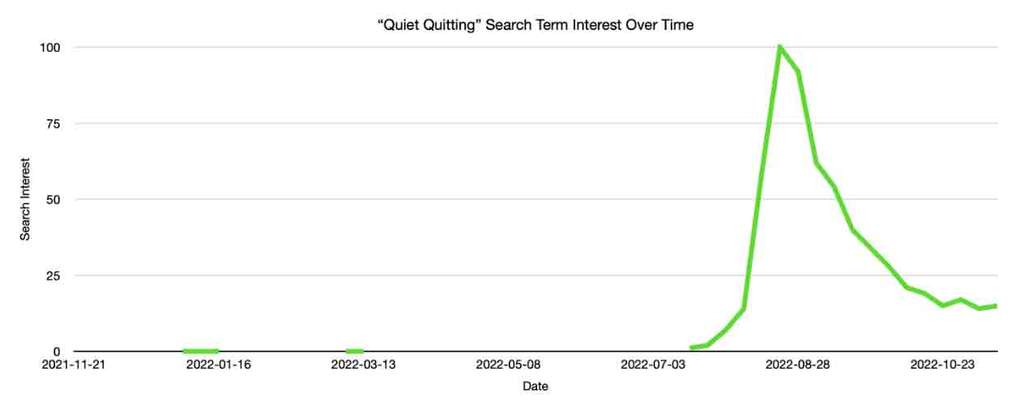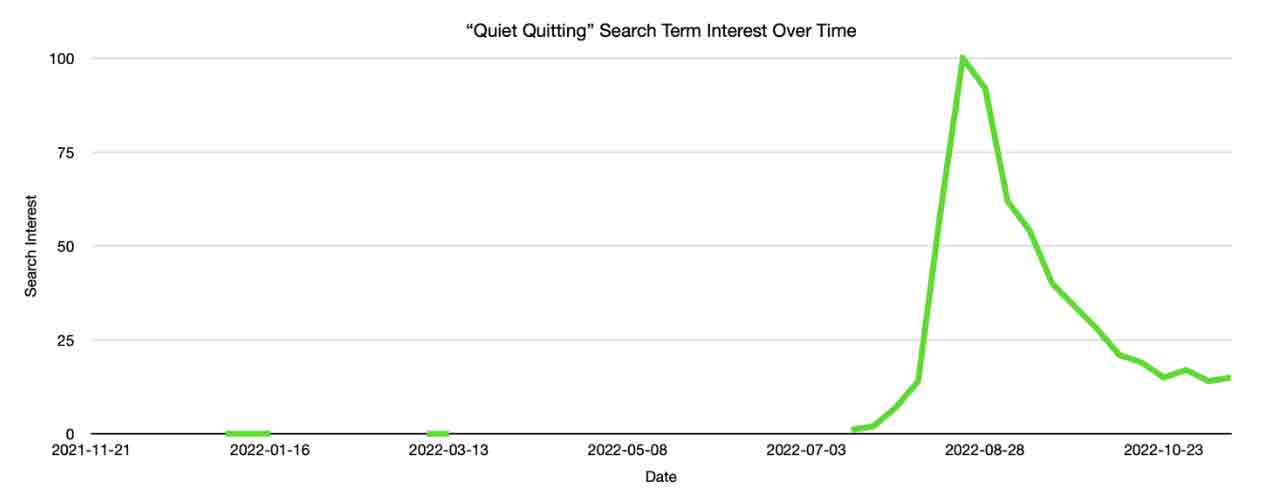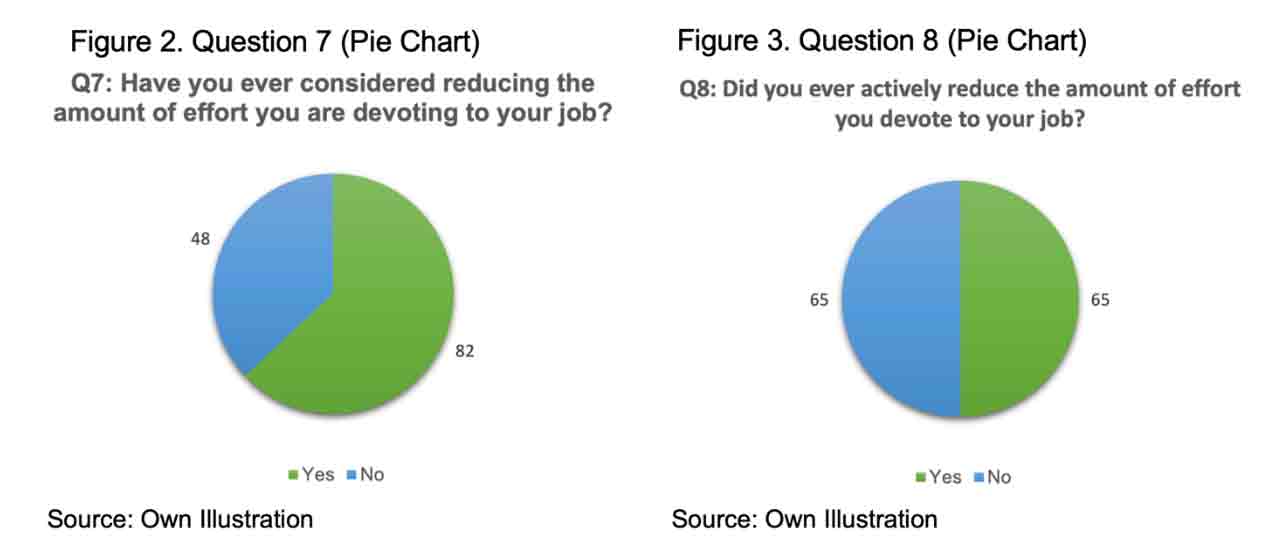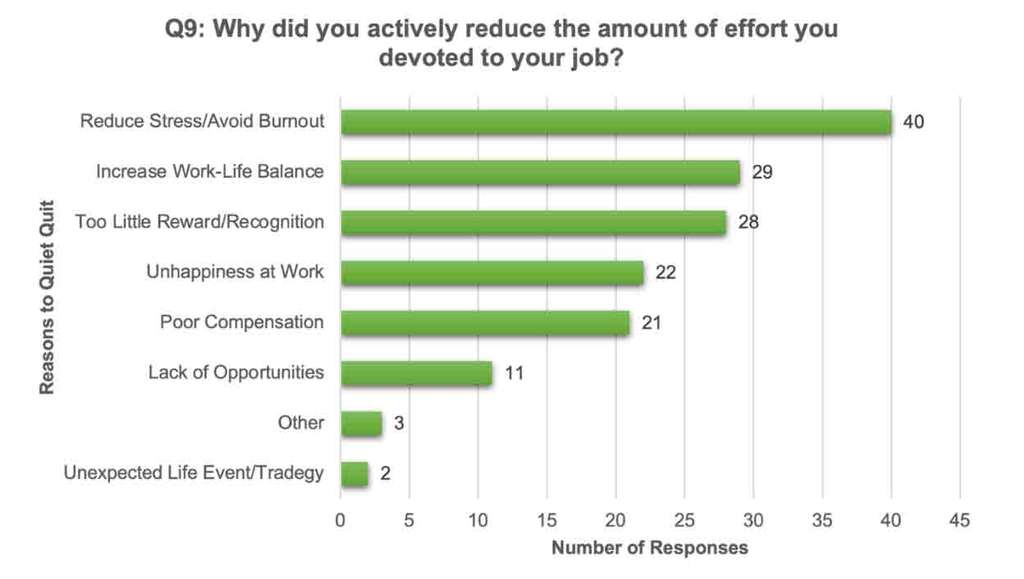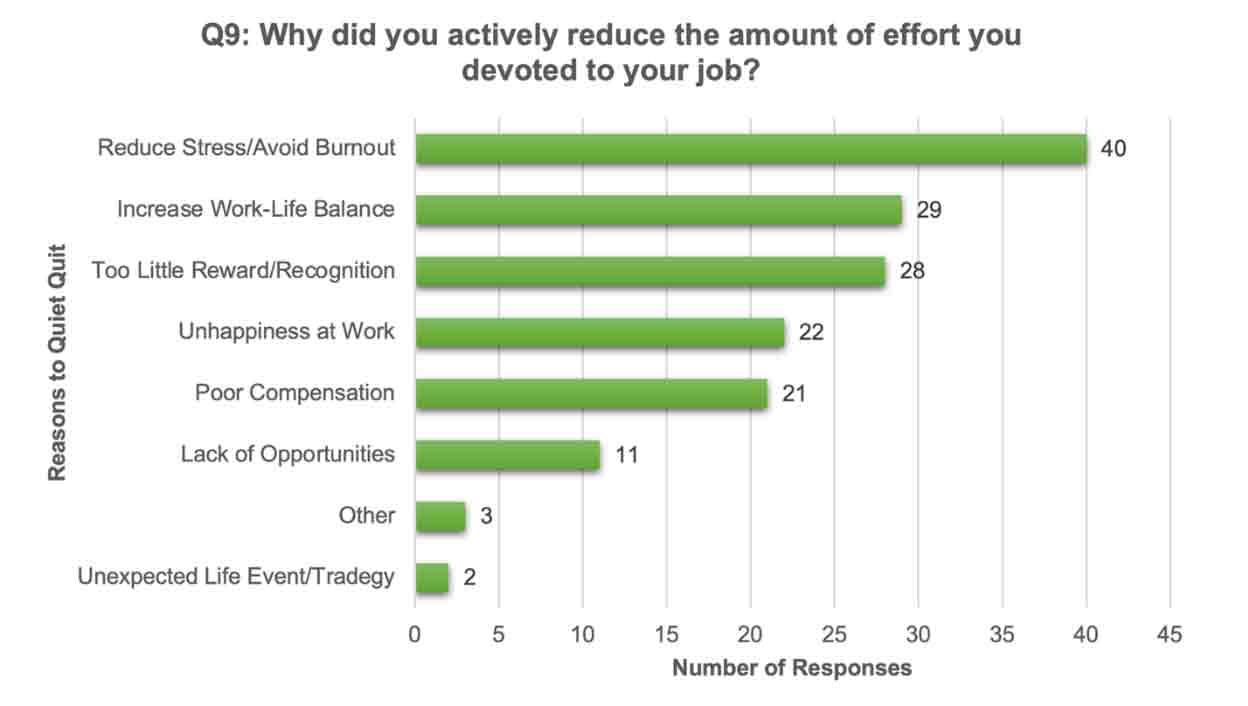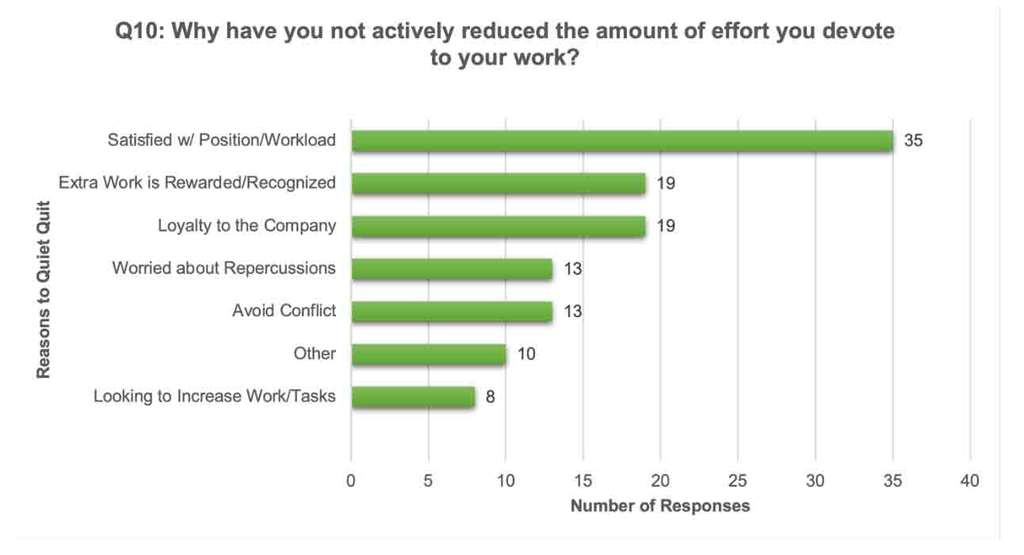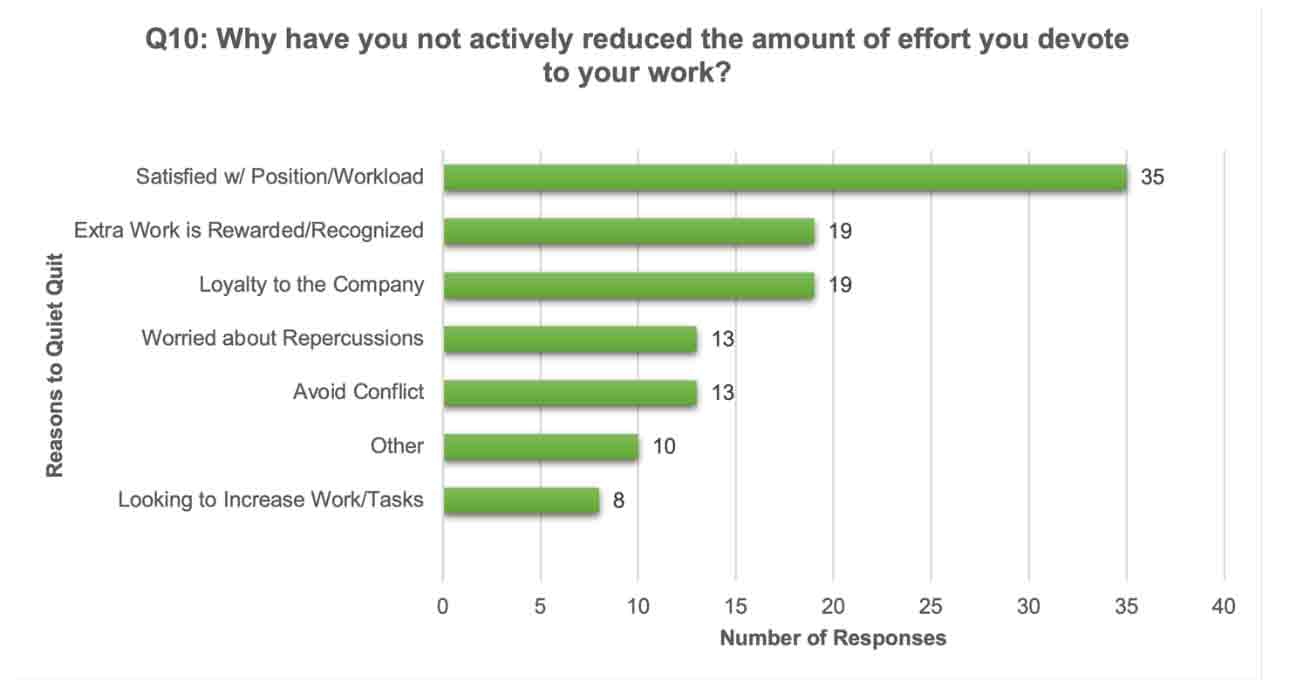Quiet Quitting: An Investigation Into the Reasons and Motivations Behind this Workplace Challenge: Part I
Abstract
This research utilized an online survey questionnaire and specifically asked whether people considered quiet quitting, and the responses overwhelmingly fit with the themes identified in the literature as well as what has been published in newspapers and articles.
Gallup completed market research titled “Is Quiet Quitting Real?”; In this article, they discussed employee engagement based on the assumption that employee engagement is positively linked to and one of the reasons behind quiet quitting. They stipulated that: “Quiet quitters" make up at least 50% of the U.S. workforce. (Harter, 2022).
Quiet Quitting is one of the most prevalent topics in the media and the workforce today. It followed the equally complicated phenomenon of The Great Resignation and seemingly broached similar concepts and theories. It is debated, however, if Quiet Quitting truly is a new trend or if it is something the corporate world, business owners, and human resource managers have dealt with before. Therefore, this study investigated how prevalent Quiet Quitting is and aimed to identify why a person would or would not partake in quiet quitting. The research focuses on anyone over the age of 18, who currently has a job or has previously worked. To this end, a self-completion questionnaire was sent out via email, text, and social media platforms. The survey contained questions intended to examine potential motivations behind the decision to quiet quit or not. Through data collection and secondary research, it was possible to recognize certain commonalities between the literature and already existing concepts. Businesses and human resource managers must be prepared to adjust their company culture for a workforce that can only be described as “the new normal”. One question from this study, Did you ever actively reduce the amount of effort you devote to your job?
, resulted in exactly 50% of respondents saying Yes
which reflects the results Gallup’s market research showed.
Keywords: Quiet Quitting Employee Engagement Employee Satisfaction Employee Motivation Work-Life Balance Turnover Rate Job Insecurity COVID-19 Company Culture
Introduction
When the workforce stops going the extra mile, employers potentially start encountering a multitude of problems. But how prevalent is this seemingly novel trend of quiet quitting exactly, and is it an entirely new phenomenon, or has the world seen it before? First and foremost, quiet quitting does not necessarily mean what the name leads its reader to believe. Employees do everything but actually quit: you’re not outright quitting your job, but you’re quitting the idea of going above and beyond.
(Krueger, 2022, para. 1). It is also defined as: reducing the amount of effort one devotes to one’s job, such as by stopping the completion of any tasks not explicitly stated in the job description.
(Dictionary.com, 2022, para. 1). The term has survived multiple news cycles and has caused widespread worry among business owners and CEOs, but where did it come from?
Examining data such as Google Trends shows that “quiet quitting” as a search term started gaining traction in July 2022 and reached its peak in August 2022. Figure 1 illustrates the progression the interest in the term on Google has made and that it started to taper off towards September and October (Google Trends, 2022).
Figure 1. Google Trends for the Term “Quiet Quitting”
Reasons and Motivations: Less Hustle, More Crafting
Leaders can retain the positive aspects of citizenship behavior without subjecting their teams to an unsustainable “hustle” culture. Instead of promoting an “always-on” mindset that ends up burning people out, leaders should encourage employees to pursue what we call citizenship crafting (When Quiet Quitting Is Worse Than the Real Thing, by Anthony C. Klotz and Mark C. Bolino, Harvard Business Review September 15, 2022).
In an unhealthy workplace culture, employees often feel compelled to go above and beyond in ways that harm their well-being, such as by taking on additional projects that cause them to miss out on important family or social events. But if employees can prioritize citizenship behaviors that align with their own motivations and needs, these activities can be energizing rather than burdensome. An example of this, some employees may be driven by helping others, and so they may be excited to take on extra tasks when there’s a prosocial component. Others may be more motivated by public recognition, and so they may benefit more from focusing on citizenship activities that are highly visible within the organization. A manager’s job is to listen to their employees, help them determine the specific forms of citizenship that align with their intrinsic motivations, and encourage workers to focus on these tasks if and when they have the bandwidth to go beyond their core job duties.
While its disruption to organizational functioning may be less visible than that of the Great Resignation, quiet quitting can in fact be even more damaging. To address this challenge, leaders must focus on motivating employees to fulfill their core tasks, listen to workers, and address their unique needs, and create a culture that invites workers to craft their own approaches to citizenship (When Quiet Quitting Is Worse Than the Real Thing, by Anthony C. Klotz and Mark C. Bolino, Harvard Business Review September 15, 2022).
According to the Los Angeles Times, a story initially published in The Insider seemingly inspired career coach Bryan Creely to utter the words “quiet quitting” for the first time (Pearce, 2022). He was one of the millions who were laid off during the pandemic and subsequently began to upload videos to the internet platforms YouTube and TikTok.
While the phrase Are you somebody that has quiet quit on the job?
(Ito, 2022) has been attributed to Creely, others believe the phenomenon has been around for far longer under a different name. The so-called “lying flat” movement (“tang ping” in Mandarin) in China has similar implications as quiet quitting does (Chitty, 2022): employees re-evaluate their work-life balance and their commitment to their work (Davidovic, 2022).
The assumption that quiet quitting is nothing new goes further, however. Many academics, especially those focusing on Organizational Behavior and Human Resources, have recognized that quiet quitting is a re-packaged trend behind which one can find behaviors and dynamics that have long been researched (Christian, 2022; Spector, 2022; Stillman, 2022). If that is the case, why has the interest in quiet quitting skyrocketed now?
Quiet quitting is not the only incredibly impactful phenomenon that has had employers and businesses in their grip since the COVID-19 pandemic. The Great Resignation, a term first coined by Anthony Klotz, a professor at Texas A&M University, was the perhaps inevitable result of a terrible pandemic, economic uncertainty, and a subsequent wave of burnout among white-collar workers (McGregor, 2021).
Over time, numerous suggestions and attempts to re-name the situation came up: The Great Reshuffling, The Great Realization, The Great Questioning, and others tried to take its place; however, The Great Resignation stuck, and so did its consequences. This economic trend meant that people were voluntarily resigning from their jobs and, in a way, leaving corporate America behind.
Some of the most cited reasons for voluntary quitting include (Parker & Horowitz, 2022):
- Pay is too low
- No opportunities for advancement
- Not enough flexibility in their work
- Benefits were not good
Quiet Quitting: Reasons and Motivations
Even though quiet quitting has recently received news coverage and widespread attention, similar themes and concepts to The Great Resignation have surfaced. Quiet quitting could be seen as the precursor to people actually leaving the workplace, or it perhaps is the result of an aftermath that has left people re-evaluating their lives, well-being, and priorities.
Therefore, this current study investigated the trend of quiet quitting further, trying to establish common motivations and themes behind the process. As the world has become a different place as a consequence of the pandemic, the corporate world also must grapple with a new normal and must be prepared for a workforce that might not be willing to go above and beyond anymore.
Methodology
Population and Sample
As this study is investigating quiet quitting and motivations associated with the phenomenon, it was decided that everyone aged 18 and older who currently has a job or has worked before would be the appropriate choice for the population. The sampling techniques include convenience sampling, i.e., individuals who are easily accessible to the researcher (family, friends, colleagues) were directly asked to participate. Voluntary response sampling was also employed as the survey was sent out via email to all students at Northern Arizona University (NAU). Additionally, the survey link was posted on several social media platforms, such as Instagram and Facebook.
Data Collection Process
The self-completion online questionnaire was created on kwiksurvey.com and was distributed within one week in November The collection process happened entirely online, and the survey was distributed via text, email, group chats, Facebook, Instagram, and Twitter.
Some Key Results and Discussion
The self-completion online questionnaire included closed questions and utilized ranking as well as Likert-type scales. The questionnaire consists of fourteen items, out of which nine were questions used to gain a deeper inside into employee satisfaction and motivations behind quiet quitting. Question seven (Figure 2) of the questionnaire specifically asked whether people considered quiet quitting, and the responses overwhelmingly fit with the themes identified in the literature as well as what has been published in newspapers and articles. Item number eight (Figure 8) is a yes-or-no question with a built-in logic path that presents one additional question to those who answered “yes” and a different additional question to those participants who clicked on “no.” Consequently, each participant was presented with thirteen different items, of which eight were questions related to the literature review and the research aims and objectives. There were 130 total respondents to the survey.
Results and Recommendations
The number one motivation stated by respondents why they quiet quit before was to reduce stress and avoid burnout (Figure 4). As discussed at the beginning of this study, looming burnout was also the number one reason for people who were part of The Great Resignation and voluntarily resigned. Wanting to increase their work-life balance, receiving too little reward and too little recognition, as well as feeling unhappy at work were the same most stated reasons across publications and this study. It is evident that what academics and researchers have noted for years, people re-evaluating their priorities and being unwilling to live to only work is the same force behind the newly coined “Quiet Quitting” phenomenon (Adisa et al., 2022; Emslie & Hunt, 2009).
Figure 4. Question 9 (Frequency)
On the other hand, Figure 5 illustrates the motivations respondents had to not quiet quit. The number one reason for respondents not to have participated in quiet quitting, even if they had previously considered it, was their satisfaction with their position and workload. This reflects the existing literature discussed earlier, as satisfaction is cited as one of the most significant influences for low employee turnover and employees displaying company loyal behavior.
Extra work being recognized and rewarded as well as loyalty to the company were the two next most important reasons for respondents. Except for “looking to increase work/tasks,” all positively connotated motivations ranked higher than the negatively associated ones; “worried about repercussions” and “to avoid conflict.” This demonstrates that employees being satisfied or feeling recognized are more significant reasons that keep people from quiet quitting than simply wanting to avoid conflict or negative consequences.
Figure 5. Question 10 (Frequency)
Quiet Quitting: Some Reasons and Motivations
Through data collection and secondary research, it was possible to recognize certain commonalities between the literature and already existing concepts. Businesses and human resource managers must be prepared to adjust their company culture for a workforce that can only be described as “the new normal.” One question from this current study, Did you ever actively reduce the amount of effort you devote to your job?
resulted in exactly 50% of respondents saying “Yes.”
Conclusions from this research study suggest that if companies do not want to keep losing their skilled, knowledgeable, and trained employees, they cannot afford to not pay attention to current trends or phenomena such as “Quiet Quitting.” This is so important to understand because the underlying concepts and driving forces are not inherently new. Aspects such as employee engagement, satisfaction, and motivation act as the pillars of the modern workforce, especially for successful companies.
Employee Motivation and Performance
Motivation is known as the psychological driver or power which controls the way of an individual’s level of determination, along with an individual’s tendency to face hurdles.
(Shaikh et al., 2018). Some of the most important factors that influence employee motivation include a fair salary (and, almost more crucial, that the employee perceives it as fair), job security, receiving feedback and recognition, and a certain level of flexibility (Tudor & Petre, 2021). Employee motivation is directly linked to performance since an unmotivated employee, whether they lack intrinsic or extrinsic motivation, will not be able to accomplish as much as they otherwise would. Therefore, if companies are not able to properly motivate their employees, they cannot expect individuals to take on more work that goes beyond their initial job description and actual tasks.
Engagement and Turnover Rate
The two areas of employee engagement and a company’s turnover rate are so closely linked that engagement could be the only factor preventing an employee from quiet quitting. Managers need to pay close attention to any indicators that suggest employee engagement is declining, especially when paired with a higher-than-usual attrition rate.
Company Culture
Most of the concepts related to quiet quitting can be seen as a part of the company culture: feedback, rewards, and recognition, as well as leadership, morale, and management styles. People want to be treated well, particularly in a place like their work where they spend a substantial part of their life. Unhappiness and mistreatment are two of the main reasons why people started to resign or quiet quit voluntarily. Furthermore, going above and beyond/the extra mile should not be expected of anyone. First, it violates the psychological contract employees have when tasks and responsibilities are defined, but then “something more” becomes part of their job. While job enrichment naturally is a good thing, as it improves employee engagement and satisfaction, it has to happen because the employee wants to do it. They should not be forced to take on more because it might help the manager or company at that moment. The second problem with simply expecting “more” at all times is that employees do not get adequately recognized for working hard and going further than their job description. Without being rewarded for their efforts, they will not want to keep trying as hard.
Employers Need to Respect Work-Life Balance and Boundaries
Work-Life Balance evidently plays a crucial role when it comes to engagement, satisfaction, and motivation. Both in the literature as well as in the results of this study it is apparent that employees are more likely to re-evaluate their life and priorities (maybe more than they ever have been before). As Work-Life Balance is a very subjective and personal aspect, there cannot be a one-size-fits-all solution. Naturally, a company must make sure that all needs of the business are met, and tasks, jobs, and projects get completed. However, offering flexibility wherever possible and trusting employees to do their work even when they might be remote should be the minimum offered. With the workplace and life, in general, becoming more and more demanding (pandemics, natural disasters, a war on European soil, the worst economic recession since the Great Depression, etc.), the risk to employees’ mental health and overall well-being is greater than ever (Brassey et al., 2022)
Gallup Inc., the renowned analytics and advisory company, published an article including their own market research titled “Is Quiet Quitting Real?”. In this article, they discussed employee engagement based on the assumption that employee engagement is positively linked to and one of the reasons behind quiet quitting. They stipulated that: “Quiet quitters" make up at least 50% of the U.S. workforce. (Harter, 2022). Question eight, Did you ever actively reduce the amount of effort you devote to your job?
resulted in exactly 50% of respondents saying "yes". While the sample included people from outside the United States, the results of this current research study showed similar tendencies.
In summary, Quiet Quitting is one of the most prevalent topics in the media and the workforce today. It followed the equally complicated phenomenon of The Great Resignation and seemingly broached similar concepts and theories. It is debated, however, if Quiet Quitting truly is a new trend or if it is something the corporate world, business owners, and human resource managers have dealt with before. Therefore, this study examined some of the potential solutions that leaders can employ in their organizations to help mitigate employee quiet quitting in the workplace.
References
- Evaluating the use of Net Promoter Score in healthcare: A systematic review. Health Expectations, 25(5), 2328-2328–2339. CINAHL Complete.
https://doi.org/10.1111/hex.13577 - Brassey, J., Coe, E., Dehwurst, M., Enomoto, K., & Jeffery, B. (2022, May 27). Addressing employee burnout: Are you solving the right problem? | McKinsey.
https://www.mckinsey.com/mhi/our-insights/addressing-employee-burnout-are-you-solvingthe-right-problem - Chitty, T. (2022, October 9). Why “quiet quitting” was well underway in China before the rest of the world caught on. CNBC. https://www.cnbc.com/video/2022/10/10/why-china-wasquiet-quitting-well-before-the-rest-of-the-world-caught-on.html
- Christian, A. (2022, August 29). Why ‘quiet quitting’ is nothing new.
https://www.bbc.com/worklife/article/20220825-why-quiet-quitting-is-nothing-new - Google Trends. (2022, November 20). Google Trends.
https://trends.google.com/trends/explore?q=quiet%20quitting - Harter, J. (2022, September 6). Is Quiet Quitting Real? Gallup.Com.
https://www.gallup.com/workplace/398306/quiet-quitting-real.aspx - Ito, A. (2022, March 2). “My company is not my family”: Fed up with long hours, many employees have quietly decided to take it easy at work rather than quit their jobs. Business Insider.
https://www.businessinsider.com/overachievers-leaning-back-hustle-culture-coastingemployees-work - Krueger, A. (2022, August 23). Who Is Quiet Quitting For? The New York Times.
https://www.nytimes.com/2022/08/23/style/quiet-quitting-tiktok.html - McGregor, J. (2021, December 14). Careers Weekly: All The Other Names For The ‘Great Resignation,’ Omicron Is Crashing Return To Office Plans And More. Forbes.
https://www.forbes.com/sites/jenamcgregor/2021/12/14/careers-weekly-all-the-other-namesfor-the-great-resignation-omicron-is-crashing-return-to-office-plans-and-more/ - Parker, K., & Horowitz, J. M. (2022, March 9). Majority of workers who quit a job in 2021 cite low pay, no opportunities for advancement, feeling disrespected. Pew Research Center. https://www.pewresearch.org/fact-tank/2022/03/09/majority-of-workers-who-quit-a-job-in2021-cite-low-pay-no-opportunities-for-advancement-feeling-disrespected/
- Pearce, M. (2022, August 27). Gen Z didn’t coin ’quiet quitting’—Gen X did. Los Angeles Times. https://www.latimes.com/entertainment-arts/story/2022-08-27/la-ent-quiet-quitting-origins
- Spector, P. E. (2022, August 29). What Is Quiet Quitting?
https://paulspector.com/what-is-quiet-quitting/ - Stillman, J. (2022, September 14). “Quiet Quitting” Is Just a Trendy New Name for a Very Old Idea. Inc.Com. https://www.inc.com/jessica-stillman/quiet-quitting-hiring-engagement.html
